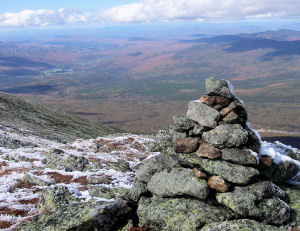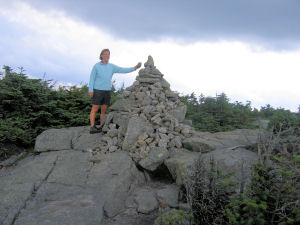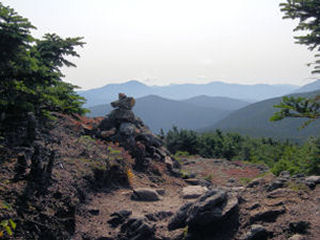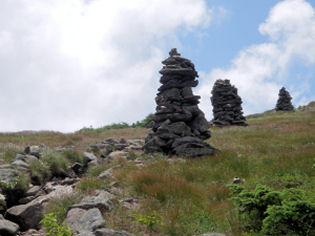Cairns 101
Nancy -- August 20, 2006
 I lean down and scoop up a loose granite rock from the trail. It's warm from the sun and has flecks of mica and pink quartz in it. Reaching the cairn, I check out the pile of rocks and place mine on top. It's my way of saying -- "Hey, I'm here and I'm lovin' it! Thanks!" As I climb, I glance back to make sure my rock is still there. I lean down and scoop up a loose granite rock from the trail. It's warm from the sun and has flecks of mica and pink quartz in it. Reaching the cairn, I check out the pile of rocks and place mine on top. It's my way of saying -- "Hey, I'm here and I'm lovin' it! Thanks!" As I climb, I glance back to make sure my rock is still there.
Walking away I notice a park sign: Preserve the mountain landscape. Please do not add to or build cairns or other rock objects. Leave the mountain and the rocks as you find them. I stop and stare and let the message sink in. Okay - wait a minute here. I can't put a rock on top of another rock on a trail of rocks? Is that what they're telling me? The sign detracts from the landscape more than my rock! What are they thinking? Now, I'm a law-abiding citizen; well, pretty much. I drive too fast and I jay-walk and I... Anyway, I'm not going to remove my stone, no way Jose! It's one of the coolest traditions in hiking!
We are climbing Cadillac Mountain (elevation 1,532), the highest point along the North Atlantic seaboard, in Acadia National Park, Maine. There are cairns all along the exposed North Ridge Trail to the summit, each made with a few large rocks. Often there's a pile of smaller rocks swept aside somewhere near the cairn. I flash back to the sign and realize what's happening. My guess is park rangers do regular trail maintenance and when they come upon a cairn that has been loved by being added to, they sweep away the superfluous rocks, leaving only what they believe is the appropriate minimal structure.

A Scottish word, cairn means a pile of stones. Cairns are used worldwide to mark trails above the tree line and the summits of mountains. In Scotland, it is a time-honored tradition to carry a stone from the bottom of the hill to place on a cairn at the top. As more people climb the hill, the cairn grows, rewarding hikers who happen upon it and offering an opportunity to add their two cents. An old Scots Gaelic blessing goes "Cuiridh mi clach air do charn." I'll put a stone on your cairn. I love that!
Much of my life has been about creating opportunities for people to leave their stone on a cairn of community. Every October, Keene's Pumpkin Festival invites the world to bring a carved pumpkin downtown in an attempt to break our own World Record for the largest number of lit jack-o'-lanterns (the current record is 28,952). But the Festival is not about setting a Guinness record; it's about bringing people together to create magic and build community through shared purpose. Like choosing the perfect rock to place on a cairn, people carve their pumpkins in personal ways -- with faces, names of people they love, special dates, company logos, messages to the world - and we light them and put the glowing gourds cheek-to-cheek on 40-foot-high scaffolding pyramids. It gives me goose bumps.
Like pumpkins at the Pumpkin Festival and stones in a cairn, the whole is greater than the sum of its parts. Thousands of pumpkins shimmering at once are more amazing than one; tens of rocks piled onto one cairn are strong enough to weather the storms and still point the way. To be a part of a unified endeavor and know your contribution matters is incredibly meaningful and rewarding. Keene gets it. Clearly, the Scots get it. Hikers get it. Pat and I get it. I bet you get it. Cairns are not only a way to mark a trail, but a way for everyone to join in, to be a part of the collective climbing experience, and a way to leave a piece of themselves, a thank-you gift, behind. Together, one hiker at a time, we create a magnificent cairn, a tribute to the joy of hiking.

Pat, my hiking buddy, and I have seen some amazing cairns. On the Sharon Ledges in the Monadnock Region there are pillar-shaped cairns that are over 5 or 6 feet tall and there is one cairn that supports an immense vertical rock the shape of New Hampshire. Yesterday on the Wapack Trail, we saw a squat pile of jumbo rocks with mica chips scattered on the large flat rock on top - like sprinkled fairy dust. Who would want to put the kibosh on that?
Acadia. They missed the Cairns 101 class where Hiking and Park pedagogy describe the thousand-year history of cairns and extol the benefits of the classic hiker participation model of trail maintenance. And they must have missed the accompanying Human Resources Special Lecture Series for Park Rangers, "Carin' for Cairns," where they test cairn development and invariably show the positive outcomes associated with hiker participation such as park buy-in and cairn creativity. And they, sadly, never got the Scottish language lesson to translate "Cuiridh mi clach air do charn." The Acadia philosophy is minimalist when it comes to cairns. They want the cairns to remain as a four-rock set, so as not to detract from the natural landscape or endanger hikers. Com' on guys - didn't you ever play with building blocks? Who stops at four?

Acadia. They use the Bates cairn, named after a trail builder named Waldron Bates who introduced this simplistic style cairn in the early 1900s. He obviously missed the Scottish lesson as well. The Bates cairn consists of two large base stones supporting a mantel between them. A fourth rock rests on top, supposedly pointing in the direction of the trail. Okay...whatever...
Cairns mark our journey. When seen ahead of us on the trail, cairns point the way. And don't we all need something or someone to point the way for us now and then? When we add to the cairn, we help make the marker more significant, to point the way more clearly for others. When we look behind us, the cairns show where we have been; journey markers along the trail of life.
Leaving a stone on a cairn is a way to ensure our spirit remains after we're no longer on the trail. We live on after we're gone. The Chinese say you gain immortality if you write a book, have a child or plant a tree. I'll add: set a Guinness record, leave big bucks to a nonprofit organization (hey, I'm a development director, what can I say?) and put your handprint in wet cement. Perhaps the easiest way is to put a stone on a cairn...except in Acadia.
|



